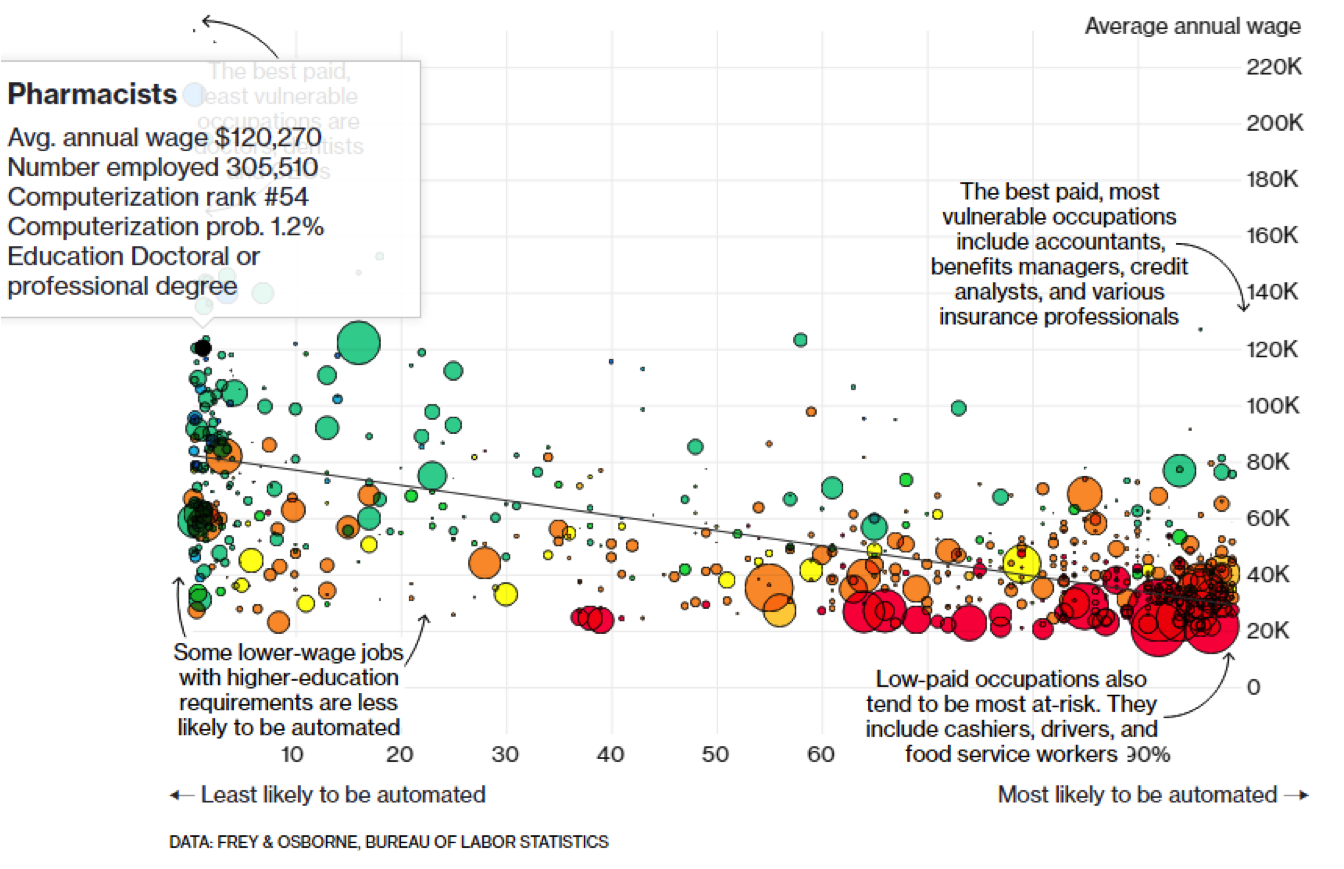All of my ex-girlfriends will tell you that I’m an over-thinker. And most would probably pull you in close and let you know that it’s not the thinking that’s the problem; it’s the worrying. One of the easiest things to worry about when you have six-figures of student loan debt from your career is the future and your ability to successfully deal with it. A rudimentary search of the future of work will bring up any number of ulcer-inducing search results. These results are usually linked to dire predictions about how technology is on the fast track to replace human beings in the workplace. Unfortunately, there’s no mention of whether these robots will also be paying off student loans.
A simple Google search with the terms” pharmacy jobs” & “Automation” turns up a couple concerning articles:
“Could a Robot Do a Pharmacist’s Job?” – Pharmacy Times
“3 White collar Jobs that Robots are already mastering” – PBS
‘Robots and AI will likely Claim Your Job, Sooner than you Think” – Huffington Post
These headlines highlight how technology is drastically affecting how we all work. There is some concern that technology may make some jobs totally obsolete and we’ve all traveled to our local grocery store and seen the automated cashiers taking over. As a practicing pharmacist I’ve been interested in how technology is going to affect future work environments and job prospects.
I’m hoping to try to get some clarity about what the future landscape is looking like for pharmacists.
Lets take a look at the “bad news” first.
Martin Ford, author of the book “The Rise of the Robots: Technology and the Threat of a Jobless Future”, as foreshadowed by the bleak title discusses the impact of accelerating change and artificial intelligence will have on the labor market. Martin Ford’s thesis is that there will be unprecedented social and economic disruption, as educated workers will no longer be able to find employment and predicts“75% unemployment by 2100.” (Wikipedia, 2018)
I graduated pharmacy school in 2011 and just in the 7 or so years that I have been practicing I can see the blistering pace of technology and how it has made inroads into my daily life. I started college without the benefit of a cell phone and didn’t get one until my sophomore year. My daughter had one at 10 years old. I watched the local grocery store replace cashiers with the self-checkout aisle (which as a closet introvert I often prefer). I’ve seen pharmacy programs get upgraded from strictly order entry modules with drug alerts to sprawling software suites with clinical decision support and the flexibility to serve the entire health care team. I’ve both been a cheerleader of technology (hey Netflix!), and the grumpy old man when newer technology takes away something that I had grown accustomed to (Bye Blackberry phone and physical keyboards).
Even with all the benefits of technology, I can’t help but feel a bit worried when I contemplate the changes that might lie ahead for pharmacy. Healthcare is a heavily regulated industry, and a fierce political topic of debate. I decided to put my worry to good use and see if there is anything I could glean from publicly available information about the future of Pharmacy x Technology.
A 2016 Report from the Barack Obama administration takes a look at the future of employment and the effect of technology. It notes that “Researchers estimates on the scale of threatened jobs over the next decade or two range from 9 to 47%. For context, every 3 months about 6 percent of jobs in the economy are destroyed by shrinking or closing businesses, while a slightly larger percentage of jobs are added – resulting in rising employment and a roughly constant unemployment…Research consistently finds that the jobs that the jobs that are threatened by automation are highly concentrated among lower-paid, lower-skilled, and less-educated workers.”
It goes on to note a couple different possible scenarios
- A “Superstar-based” technological change, where the benefits of technology accrue to a even smaller portion of society than just highly-skilled workers
- Combination of higher wages, productivity, and more opportunities for leisure for a wide range of workers
A McKinsey study released in 2017 offered the opinion that “about half” of activities in the world’s workforce “could potentially be automated by adapting currently demonstrated technologies” A PwC (PriceWaterHouseCooper) report concluded that around a third of jobs in the US, Germany, and Britain could be eliminated by automation by the early 2030s.
Vivek Wadhwa, a tech entrepreneur and faculty member at Carnegie Mellon University, has even more extreme views, saying that “studies are underestimating the impact of technology” and that “80 to 90 percent of jobs will be eliminated in the next 10-15 years.” (ChinaDaily.com.cn, 2017)
Now for the good news.
One of the first visualizations I came across that I came across was from a study “The future of Employment: How Susceptible Are Jobs to Computerization” by Carl Frey and Michael Osborne. In this study, Osborne and Frey, warn that technology will destroy 47% of U.S. jobs in the next 20 years. These authors relied on task measures from the Department of Labor, which assessed occupations based on factors such as how much manual dexterity or social perceptiveness an occupation requires. If their risk score of automation was above 0.7 then the job was high risk for automation.
I recommend you take a look at the nifty graph in this Bloomberg article that references the Frey and Osborne study, where you are able to search your particular job and see the risk of automation/computerization to your particular job.

Pharmacists are located on the side of the graph with a relatively low risk of automation/computerization. This is not the only good news. An article by Robert D. Atkinson, president of the Information Technology and Innovation Foundation provides a counterpoint to some of the alarmist articles that are available on the impact that technology will have on the job market.
The Information Technology and Innovation Foundation (ITIF), was recognized as the world’s top think tank for science and technology policy in the latest edition of the University of Pennsylvania’s “Global Go To Think Tank Index”. Robert Atkinson was appointed by President Clinton to the Commission on Workers, Communities, and Economic Change in the New Economy; the Bush administration appointed him chair of the congressionally created National Surface Transportation Infrastructure Financing Commission; and the Obama administration appointed him to the National Innovation and Competitiveness Strategy Advisory Board.
According to Atkinson, the Frey and Osborne study had some glaring weaknesses. One of which was that the study was not peer-reviewed, and neglected to examine all 702 U.S. occupational categories to manually assess how likely it is that a particular job would be able to replace a human with a machine. The ITIF conducted its own manual analysis of the 702 U.S. occupational categories and came up with a more specific “risk of automation” score estimates from the U.S. Bureau of Labor Statistics (BLS’s) employment projection data series for 2014-2024. They analyzed each of the 840 occupations and assigned a “risk” level to each of the occupation on a scale of 1-5, with 1 being most at risk of automation and 5 being least at risk. They sorted occupations by educational requirements with the assumption that these occupations would be the most at risk and more likely to be substituted by technology. Then they evaluated the job scope and the presence of technologies that would have the possibility to radically alter them. (ITIF.Org, 2017)
They found that that a job’s “at-risk” level was weakly correlated with education, with a correlation coefficient of -0.4.
They concluded, 8% of workers are employed in “high-risk” occupations, 33 percent are in “moderately high-risk” occupations, 16% percent are in “moderate-risk occupations, 28% are in “moderately low-risk occupations, and 15% in low-risk occupations. (You can find their downloadable Excel Spreadsheet detailing occupations and risk levels here)
Taking a look at their results I found that pharmacists as an occupation are rated as a 4 or moderately low risk occupation.
Looking at the body of evidence as a whole, although technology will continue to play a larger role in all occupations. I feel pretty confident that pharmacy wont be swallowed whole by the technology apocalypse that we often hear about in popular media. This of course, is based upon the assumption that technology continues to progress as it has in the past. There is always the possibility of black swan type events (like the creation of sentient AI that takes over the world and puts all human beings out of a job) but that is of course beyond the scope of my prognostication ability.
Whew, now I can rest a little easier and stop giving my desktop the evil eye. I hope you can too.
Works Cited
ChinaDaily.com.cn. (2017, March 27). E-Paper/Across America. (Xinhua-Afp, Editor) Retrieved May 22, 2018, from http://usa.chinadaily.com.cn/epaper/2017-03/27/content_28693034.htm
ITIF.Org. (2017, August 7). Unfortunately, Technology Will Not Eliminate Many Jobs. (R. D. Atkinson, Editor) Retrieved May 23, 2018, from Innovation Files: https://itif.org/publications/2017/08/07/unfortunately-technology-will-not-eliminate-many-jobs
Manyika, J. (2017, May). Executive Briefing – McKinsey Global Institute. Retrieved May 2018, from Mckinsey Featured Insights: https://www.mckinsey.com/featured-insights/employment-and-growth/technology-jobs-and-the-future-of-work#section%202
Wikipedia. (2018). Rise of the Robots (book). Retrieved May 22, 2018, from Wikipedia: The Free Encyclopedia: https://en.wikipedia.org/wiki/Rise_of_the_Robots_(book)


Recent Comments